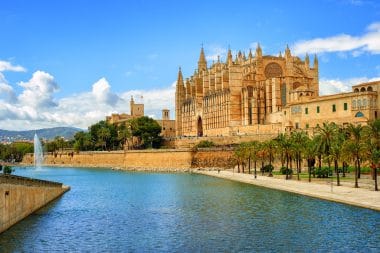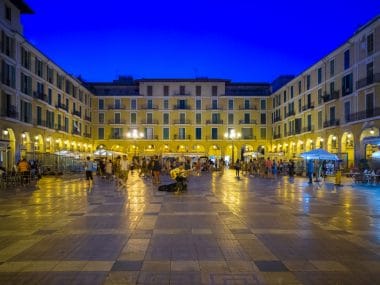Palma is the capital of the beautiful island of Mallorca. Located in the Mediterranean Sea, this city has a lot to offer tourists and locals alike. Palma de Mallorca captivates with cultural sights, relaxed atmosphere, Mediterranean climate, vibrant life, delicious tapas and good wine!
Palma is located in the southwest of the island and is located directly by the sea. With an international airport, a large port for freight traffic and also for large cruise ships, Palma has good connections. This makes it easy for holidaymakers to spend an unforgettable holiday in Palma.
The Mediterranean ambience
Palma is also very popular because of the good weather. Here you can take a lap around the large harbour in the best sunshine. The Paseo Marítimo, the generously developed sidewalk, invites you to stroll. You can see excursion boats, small sailing ships but also very large yachts. It is not uncommon to see one or the other celebrity get off his boat here.
Around the harbour you will find great restaurants. These are known for freshly caught fish and relaxed atmosphere. Some of them are also set up as beach bars. So you can already have your feet in the sand at lunch.
The old town of Palma de Mallorca
If you want to explore the old town, you should do so on foot. The many one-way streets could otherwise be very confusing. The narrow streets also make it difficult to explore the picturesque alleys.
Just let yourself be carried away by the crowd. Passing small, selected boutiques, you will always come across historic churches. The old town of Palma alone has 31 of these imposing buildings to offer.
For refreshment, there are many cafés and bars where you can let the impressions sink in with a good glass of Mallorcan wine.
An absolutely romantic tip for the old town are the horse-drawn carriages. With imposing horses, the exploration tour can be made an unforgettable excursion.
The nightlife district
The neighborhood that never sleeps. La Lonja invites you to eat, drink and dance during the day and in the evening. Jazz in particular has grown in popularity in this neighborhood. So you can dine very well here in the many restaurants and at the same time shake a leg. Due to the constant weather, all this basically takes place in the open air. There is also something for night owls here. Large dance halls and discotheques open their doors at night.
The sights
La Seu Cathedral

You can’t get around Palma’s main attraction. As soon as you enter the city, this gigantic building catches your eye. The Cathedral of La Seu, or Cathedral of St. Mary, is the symbol of the city. Well positioned near the sea, it enchants with a water feature in the garden. In the courtyard of this cathedral, especially in summer, many plays and musical performances take place.
Castell de Bellver
Also worth a visit is the former royal fortress Castell de Bellver. Those who have made it up the steps to this building will be rewarded with a breathtaking view over Palma and the sea. Here, too, a beautiful concert can be admired in the courtyard in summer.
Paseo del Borne
Not a direct sight, but still a “must see” in Palma is the Paseo del Borne. This wide shopping mile is also often compared to the Ramblas in Barcelona . The path is lined with tall trees, which provide ideal shade in the heat. It is not for nothing that this street is also called the “Golden Mile”. Because here you will find almost exclusively luxury boutiques where you can shop.
Museum Es Baluard
The most famous museum is integrated into the city walls of Palma. Es Baluard features modern and contemporary art. There is also a fine café here that invites you to linger. From here you also have a sensational view over the port of Palma.
Plaça Major

No matter how confused you may walk through the capital. Again and again you arrive at Plaça Major. This square is the main square of downtown Palma. Here you will often meet “Flying Merchants” where you can get hold of nice souvenirs.
Festivities and holidays
17 January – Sant Antoni
An absolute highlight is the holiday of Sant Antoni on 17 January. On this day, the city does not come to rest. The patron saint of animals is celebrated. This will then continue to be celebrated on the streets after the church part. Dancing demons and fire-breathers create an adventurous atmosphere.
19 January – Sant Sebastiá
Immediately afterwards, on 19 January, Sant Sebastiá is celebrated. This festival is again characterized by the demons. They parade through the city centre of Palma for a week with fire shows and drummers. Many activities around this event are designed for the whole family.
Fira del Ram Fair
In spring, Palma has a funfair atmosphere. The Fira del Ram is a big festival with Ferris wheels, snack stalls and shooting ranges. This takes place just outside the city on the large event squares.
Christmas
Palma ́’s city centre also enchants in December. In mild temperatures, you can admire the lovingly decorated alleys at Christmas time. There is also a Christmas market in the city. Mulled wine is often avoided due to the temperatures, but Mallorca’s capital attracts young and old with regional delicacies. In addition, a midnight mass is celebrated on Christmas Eve on the Paseo del Borne.

In Palma de Mallorca there is a wide variety of parking options, both on the street and in parking garages. The city has different parking zones, which are marked by white, yellow and blue stripes on the side of the road. White markings mean free parking, but such spaces are very rare. Yellow lines are reserved for disabled parking spaces, exits or loading zones and may be used at certain times. Blue zones are subject to a fee and allow parking for up to two hours.
There are 14 car parks in Palma, spread over the city centre and along the Paseo Marítimo. Parking fees in the city centre car parks are 3 cents per minute (1.80 euros per hour or part thereof), while car parks outside the Ringstrasse charge only 2 cents per minute (1.20 euros per hour). Some of the main car parks are:
- Parc de la Mar: Open 24 hours, located just below the cathedral, but can get crowded in high season.
- Plaça Major: Also open 24 hours and located just below the square of the same name, it is often crowded.
- Passeig Mallorca: Located on the western edge of the old town, open around the clock.
- Mercat del Olivar: Very centrally located under the Olivar market, open 24 hours.
- Marqués de la Senia: Ideal for night owls who want to be close to the Paseo Marítimo, open 24 hours.
In addition, there are free parking facilities at the Son Moix stadium, which is located about three and a half kilometers outside the center. From there you can take the bus to the city centre.
For visitors who move outside the paid hours, the blue ORA zones can be used free of charge. However, keep in mind that failure to comply with the rules can result in a fine, which can be reduced in half within 15 days if paid on time.
A perfect day in Palma de Mallorca
Morning: Start your day with a visit to the Gothic Cathedral of La Seu, one of Palma’s most iconic buildings. Originally built on the site of a mosque, the structure offers not only stunning architecture but also a rich history. In the immediate vicinity you will find the royal palace L’Almudaina with its magnificent gardens. A walk through the old Arab quarter behind these buildings, with its winding streets and hidden treasures, is also highly recommended.
Noon: Enjoy lunch in one of the numerous restaurants or cafes in Palma. The town offers an excellent range of culinary delights, ranging from traditional Mallorcan food to international cuisine.
Afternoon: Visit the Es Baluard Museum of Contemporary Art, housed in an old fortress. The collection includes works by Spanish artists, including Joan Miró, who spent much of his life in Mallorca. Also, take the opportunity to admire the modernist architecture in Palma, which was heavily influenced by Gaudí.
Late afternoon: Relax on one of Palma’s urban beaches or explore the nearby beaches of Portixol, Cala Major and Illetas, all of which are easily accessible by public transport or a short taxi ride.
Evening: Take part in one of the traditional festivals or cultural events if your visit coincides with one. The festivities of Sant Sebastiá in January or Sant Joan in June are particularly recommended. Alternatively, you can attend La Ruta Martiana, a gastronomic event where bars in the old town offer small tapas or pintxos along with a drink at reasonable prices every Tuesday.
Night: Explore Palma’s nightlife with its many bars, jazz clubs, and live music venues in La Llonja or other parts of the city.




